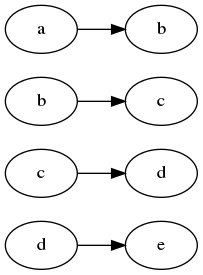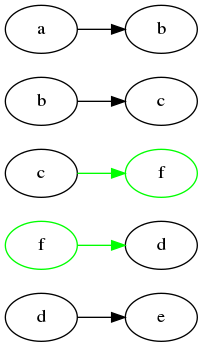Summary of a Hackers Night
Last night, interested Emacsians from around the PDX area gathered together for a hack night. Our goal was to implement a rudimentary, breadcrumb project. Following a trail of interesting parts of a large code based using the standard Xref/Tags system always seems to get me lost after a little bit, and some of the breadcrumb projects I’ve use didn’t seem intuitive (at least, not to me anyway).
Besides the basics of how to make a breadcrumb project should be easy to grasp for a group of hackers… and then extend after everyone leaves.
All I had on the screen when we began was three vaguely-worded questions:
- Data Structure? Rings vs. push and pop onto a List
- Useful functions? See
point-markerandgoto-char - Expansion ideas? Should you advice often used functions?
First Attempt
First, we played around with the built-in Ring data structure that
much of Emacs uses. We created crumbs, a ring data structure
and the current index into it, current-crumb:
(defvar crumbs (make-ring 10) "A ring of crumbs, e.g. positions in file buffers.") (defvar current-crumb 0 "An index into our ring of breadcrumbs.")
To get a marker (the point position in a file buffer and the name of
the buffer), we call the point-marker function, and insert it into
the data structure:
(defun drop-a-crumb () (interactive) (ring-insert crumbs (point-marker)))
(We originally called our ring variable, ringy and this function
droppy… hey, naming things is hard!)
To retrieve the mark from the ring structure at a particular point is straight-forward:
(ring-ref crumbs current-crumb)
But this expression returns a tuple of the buffer and the point position, so to use this we need to set both values. Our initial jump-backwards-to-a-previously-dropped-crumb function looked like:
(defun back-a-crumb () (interactive) (let ((mark (ring-ref crumbs current-crumb))) (pop-to-buffer (marker-buffer mark)) (goto-char (marker-position mark)) (setf current-crumb (1- current-crumb))))
The last line changes the crumb position backwards in our ring
structure. The ring-ref function can take any position, as negative
numbers or numbers larger than the contents simply loop back around.
Of course, this means we should have a forward function:
(defun forward-a-crumb () (interactive) (let ((mark (ring-ref crumbs current-crumb))) (pop-to-buffer (marker-buffer mark)) (goto-char (marker-position mark)) (setf current-crumb (1+ current-crumb))))
This worked reasonably well, but all the functional programmers in
the room, while deeply unhappy about all the state (it is somewhat
inevitable in Emacs Lisp), at least wanted to hide the crumbs, so we
added lexical scoping and a bit of re-factoring:
(lexical-let ((crumbs (make-ring 10)) (current-crumb 0)) (defun drop-a-crumb () (interactive) ;; Reset the position to match the drop? (setq current-crumb 0) (ring-insert crumbs (point-marker))) (defun follow-crumb (direction) (let* ((mark (ring-ref crumbs current-crumb)) (buf (marker-buffer mark)) (poit (marker-position mark))) (pop-to-buffer buf) (goto-char poit) (setf current-crumb (funcall direction current-crumb)))) (defun back-a-crumb () (interactive) (follow-crumb #'1-)) (defun forward-a-crumb () (interactive) (follow-crumb #'1+)))
Inserting into the Trail
This works in the simplistic case, however it doesn’t intuitively match our expectations. Time for the whiteboard …
For instance, what if you had the following breadcrumb trail (let’s give them symbolic names for some positions in buffers):

Let’s move into the middle of this breadcrumb trail by pointing the current variable:

What should happen if we drop a new crumb (f)? With a ring, it
either appends or pre-pends it on this list (which, for a ring, is
essentially the same thing). If we didn’t change our current
position, our structure looks like:

With this, if when we move back on the crumby trail, we end
at b (which probably has no relationship with f). However, if we
update the current pointer when we append the new mark, our
structure looks like:

But now, going backwards goes to e, which again, probably has
nothing to do with the new mark, and is even further away from c
(where we came from to set this new mark). While it seems
counter-intuitive to program, perhaps when we drop a crumb, we also
increase the counter from where we last were (c):

Now we can go backward to c, but finding f would be difficult, as
it may not be anywhere near c.
What we would expect is a mark that is inserted:

Now, if we try to go backward along our breadcrumb trail, we would
go back to c (which is intuitive), and forward from c goes to f
(expected). Forward again? This would go to d, and while this may
not be really associated with the new mark, it is at least close
enough in the mind of the breadcrumb dropper.
At least, this seemed more intuitive to us after a bit of whiteboarding.
Breadcrumb Relationship
William Clifford thought we should model (and store) the relationships of the “dropped marks”.

At this point e doesn’t point to anything, so going forward doesn’t
make sense, but normally, jumping forward means jumping to the value
associated with the current mark (on the left side in the diagram).
If the current position is c, when we move around and drop a new
breadcrumb, we insert the new mark, f, by:
- Replacing the value associated with
cto the new mark, and - Add the new mark that is associated with
c’s old value:

Yeah, I immediately started jumping to maps as well. Let’s implement this structure with an Association List to store our sequence of 5 relationship marks:
( ( :a . :b ) ( :b . :c ) ( :c . :d ) ( :d . :e ) )
With this, jumping forward means jumping to the assoc of the current
key point, and going backward means jumping to the rassoc of the
current key. And to drop a new breadcrumb, :f, we:
rassocthe value of:c(that is,:d) to be the new value destination of the new mark, e.g.( :f . :d )assocthe:cto the new current mark, e.g.( :c . :f )
Our end result would be:
( ( :a . :b ) ( :b . :c ) ( :c . :f ) ( :f . :d ) ( :d . :e ) )
I’ll let the implementation of this be an exercise to the reader, as I had another idea…
Inserting into a List
At this point, our hacking fun came to an end, and we left to have a round at a local Thai place. Traveling home on train, I got to trying the idea of inserting into simple list…
Let’s go back to our breadcrumb trail represented as a list of symbols:
(setq crumbs '(:a :b :c :d :e))
We represent the current-crumb as an index where 0 would be
pointing to the first location, :a, and if we had moved back to :c,
our current-crumb as 2.
If we wanted to insert :f, we want a function with this behavior:
(list-insert '(:a :b :c :d :e) 2 :f) ; => (:a :b :c :f :d :e) (list-insert '(:a :b :c :d :e) 0 :f) ; => (:a :f :b :c :d :e) (list-insert '(:a :b :c :d :e) 4 :f) ; => (:a :b :c :d :e :f)
Since the list will never be that long, we could make a function that creates a new list with an element inserted after some point.
(defun list-insert (lst index element) "Insert ELEMENT into the list, LIST, at INDEX, where pos == 0 would be insert." ;; The calculated position is based on the behavior of `last' and `last' (let ((pos (1- (- (length lst) index)))) (append (butlast lst pos) ; First section (list element) ; Element as a list (last lst pos)))) ; Second section
What about the extreme case of starting out?
(list-insert () 0 :a) ; => (:a)
Actually, with an empty list, the index really doesn’t matter:
(list-insert () -1 :a) ; => (:a)
Intuitive Breadcrumbs
Let’s re-factor our original breadcrumbs to use our new list-insert
function:
(lexical-let ((crumbs (list)) (current-crumb 0)) (defun drop-a-crumb () (interactive) (setq crumbs (list-insert crumbs current-crumb (point-marker))) (setq current-crumb (1+ current-crumb))) (defun follow-crumb () (if crumbs (let* ((mark (nth current-crumb crumbs)) (buf (marker-buffer mark)) (poit (marker-position mark))) (pop-to-buffer buf) (goto-char poit)))) (defun back-a-crumb () (interactive) (if (> current-crumb 0) (setq current-crumb (1- current-crumb))) (follow-crumb)) (defun forward-a-crumb () (interactive) (if (< current-crumb (1- (length crumbs))) (setq current-crumb (1+ current-crumb))) (follow-crumb)))
This works really well, except for when you want to go forward to a crumb, but the point is already there. Seems that it should honor the wish and move forward one more time. But now that the hack night is over, I tweaked this for my own shaved yak.






